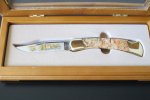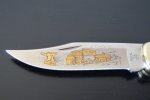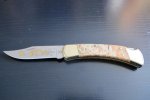View attachment 833584 View attachment 833585 View attachment 833586 Snag #2. Because the spring holder is molded into the back of the handle (not removable), it keeps me from swinging the rocker out of the way. Therefore I cannot slide the handle as far onto the jig as I would like. Placing the Helicoil on the insertion tool requires that the collar is placed such that the tang is at the bottom of the slot. This is because the Helicoil lengthens as you screw it into the threaded hole. This design has the coil exerting pressure against the female thread in the handle. It keeps the coil from coming in and out with screw. Helicoils come in different lengths usually expressed as a multiple of the diameter. After the coil is in place, the tool’s collar is slid back, the fork is lifted off the tang, given a 1/4 turn, and rapped to break the tang off. Now the knife can be assembled.




